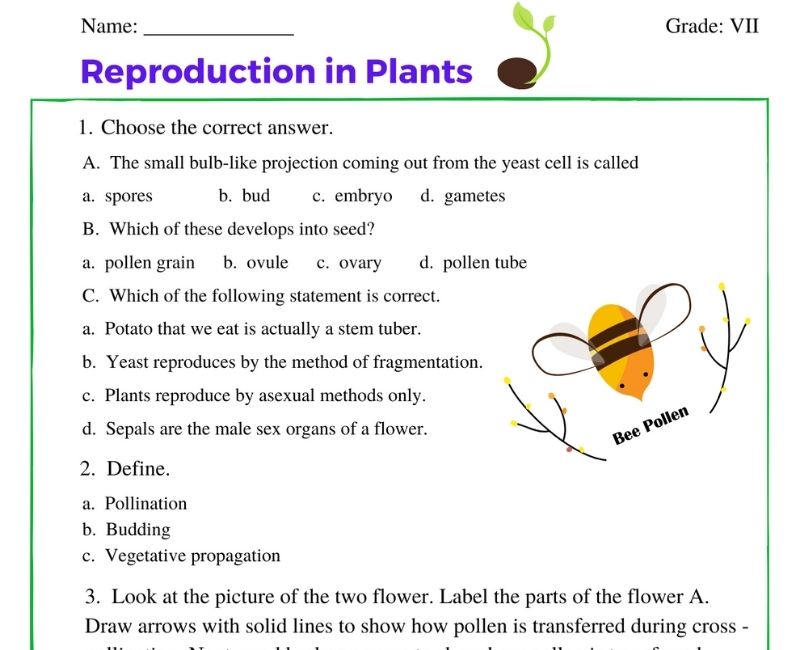Worksheet On Reproduction In Plants Class 7
Embark on an enchanting journey into the heart of nature with the Worksheet On Reproduction In Plants Class 7, a captivating exploration designed to unfold the mysteries of plant life and its perpetuation. This meticulously crafted resource serves as a gateway for young minds to delve into the fascinating world of botany, specifically the remarkable processes that enable plants to reproduce and thrive.
As you navigate through the Class 7 Chapter 8 Science Worksheet, you'll find yourself immersed in the intricate dance of life that plants perform, from the simple act of seed germination to the complex rituals of pollination and fertilization.
The Reproduction In Plants Class 7 MCQ section adds an interactive layer to your learning adventure, challenging you to apply your knowledge in a dynamic and engaging way. Each multiple-choice question not only tests your understanding but also sharpens your critical thinking skills, paving the way for a deeper appreciation of the subject. It's an excellent tool for self-assessment, ensuring that you're not just memorizing facts but truly comprehending the mechanisms that drive plant reproduction.
For those thirsty for more, the Reproduction In Plants extra questions present an opportunity to dive deeper into the subject. These questions are thoughtfully designed to push the boundaries of your knowledge and encourage a more profound inquiry into the life cycles of plants, their reproductive strategies, and the vital role they play in our ecosystem. It's an invitation to look beyond the textbook and engage with the living, breathing world of flora that surrounds us.
Completing this comprehensive suite of learning materials, the Class 7 Science Chapter 8 Questions Answer section acts as your faithful companion, guiding you through the intricacies of the topic with clarity and precision. This invaluable resource not only bolsters your understanding but also equips you with the confidence to tackle exam questions with ease. Whether you're a student eager to master the subject or a teacher looking for well-rounded educational tools, these worksheets offer a holistic approach to learning about the reproduction in plants, making the journey both enlightening and thoroughly enjoyable.
FAQs
What is reproduction in plants?
Reproduction in plants is the biological process by which plants produce new individuals or offspring. This process is crucial for the survival and continuation of plant species. It occurs through both sexual and asexual methods. In sexual reproduction, plants use flowers which develop into fruits containing seeds. When these seeds are dispersed and find suitable conditions, they grow into new plants. Asexual reproduction in plants involves producing offspring without the fusion of gametes and does not result in the formation of seeds.
What are the modes of reproduction in plants?
The two primary modes of reproduction in plants are:
Sexual reproduction: This requires the involvement of two parent plants or two different parts of a plant and includes the formation of seeds after the process of pollination and fertilization inside flowers. The seeds eventually give rise to new plants.
Asexual reproduction: Plants reproduce asexually by generating new plants from the existing parts such as roots, stems, and leaves. There is no involvement of flowers, pollination, or fertilization, and genetically identical offspring are produced from a single parent.
What are the examples of asexual reproduction in plants?
Some common examples of asexual reproduction in plants include:
Vegetative propagation: This includes reproduction through roots, stems, or leaves. Plants like strawberries propagate through runners, potatoes through tubers, and onions through bulbs.
Spore formation: Ferns and mosses reproduce through spores that are produced in sporangia.
Budding: Yeast and hydra reproduce by budding, where a new individual begins to form as a bud on the existing organism and eventually detaches to become an independent entity.
Cutting: Gardeners often use this method by planting sections of a plant's stem, roots, or leaves to grow new plants. For example, stem cuttings of rose plants can grow into new rose plants.
In such asexual processes, since there is no mixing of genetic material, the offspring are typically exact genetic copies, or clones, of the parent plant.






